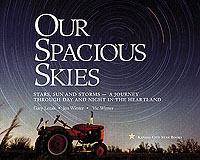
• Gary's Weather Tips - Page 110.
• Interested in learning more about the weather? You can become a good amateur weather observer by learning a few basics and by purchasing some inexpensive, easy-to-use weather instruments.
• Start by going over the cloud types we discussed on Page 13. Learn them and you’ll know how to read the fundamental clues of what weather is on the way. From there, you can:
• Buy an inexpensive rain gauge; you’ll find one at most hardware and
big variety stores. They’re quite accurate.
• Purchase a barometer and an outdoor thermometer, which can be found in stores and also on the World Wide Web by searching for “weather instruments.” The barometer tells you whether the atmospheric pressure is rising or falling. Falling pressure means lower pressure is moving toward you, and low pressure most often is associated with stormy weather. The thermometer will let you track the temperatures and some kinds will let you record the high and low temperatures for the day.
• Start a weather log. Write down the high and low temperature and the amount of rain or snow each day. Also jot down a few words explaining how you experienced that day’s weather.
• Become a weather observer for your favorite local weather television
forecaster.
• Try making your own forecast. Don’t forget rule No. 1 of weather forecasting: Always look outside. You never know what’s going to happen, and the weather can change quickly.
• There are many web sites on the internet that provide weather forecasts. From them you can gather a trove of weather data — satellite pictures, radar, and temperatures around the region and the nation.
— Gary Lezak |